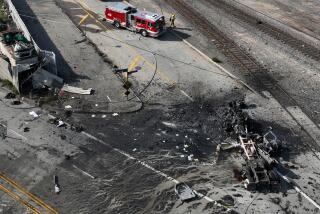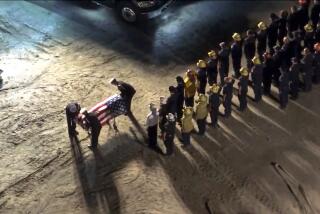Cause of Texas fertilizer plant fire may never be known
A malfunctioning golf cart, a faulty electrical system or even arson could have led to the fire that triggered the deadly explosion of a fertilizer plant in West, Texas, but federal and state officials said Thursday that their $1-million investigation had yet to find the cause.
Fourteen people died in the April 17 blast, including 12 first responders who arrived nine minutes after the fire was reported — and just eight minutes before the explosion shook the town, devastated two schools and shattered a nursing home.
An estimated 28 to 34 tons of ammonium nitrate fertilizer exploded in two stages, separated by a fraction of a second, causing damage across a 37-block area and throwing debris as far as 2 1/2 miles, according to officials from the federal Bureau of Alcohol, Tobacco, Firearms and Explosives and the Texas State Fire Marshal’s Office.
The investigation has not been able to eliminate any of three potential causes of the fire, leaving it officially “undetermined,” ATF agent Robert Champion said at a news conference in West. Although the investigation is continuing, officials said, the exact reason the fire broke out may never be known.
Officials refused to comment on whether West paramedic Bryce Reed, who was arrested last week for possessing bomb-making materials, had been cleared of involvement. But the blaze and resulting explosion remain a criminal investigation, Champion said.
A golf cart was parked in the seed room where the fire broke out, and Brian Hoback, another ATF investigator, said the carts had been known to start fires when their batteries or capacitors failed. But only the cart’s brake pad and axle were recovered, not enough to implicate or eliminate it as a cause.
The fire also could have originated in the plant’s 120-volt electrical system. A more powerful 480-volt system for heavy equipment was eliminated as a cause, as was smoking, spontaneous ignition, weather and other possibilities.
Though the cause of the fire is a mystery, the resulting explosion is better understood.
The ammonium nitrate was held in a wooden bin near the seed room. Kelly Kistner, lead investigator for the fire marshal, said the conflagration raised the temperature of the ammonium nitrate, making it less stable and subjecting it to increased pressure. Then some type of “impact” triggered the explosion, he said.
A spokeswoman for the office said that impact remained under investigation, but it could have come from a structure that collapsed because of the fire.
The detonation was equal to 15,000 to 20,000 pounds of TNT, smaller than an atomic bomb but much larger than most military ordnance. An additional 30 tons of ammonium nitrate in the plant and another 100 tons in a nearby rail car did not detonate.
The explosion created a crater 93 feet wide and 10 feet deep, displacing tens of thousands of pounds of earth. About $500,000 was spent on heavy equipment to dig out the explosion site as part of the investigation, which was conducted by 104 officials from local, state and federal agencies.
State Fire Marshal Chris Connealy said causes of fire were left as undetermined if not enough evidence could be found or if multiple causes could not be eliminated, adding that “while the scene examination has been completed, the investigation will remain open for purposes of conducting additional interviews, following up on leads, and the like.”
More to Read
Start your day right
Sign up for Essential California for news, features and recommendations from the L.A. Times and beyond in your inbox six days a week.
You may occasionally receive promotional content from the Los Angeles Times.







